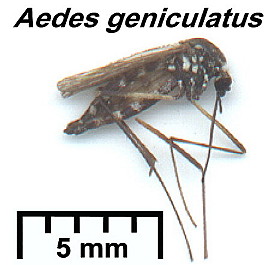Biological Clocks in Mosquitoes
|
 The type locality was Paris, France, and this
Palaearctic species is found up to the northern limits of deciduous
trees, especially oak. The range is up to 58°N in Norway, and south
throughout Europe into Algeria and Tunisia, circa 30°N (Natvig, 1948;
Stone et al., 1959). Adults may be found in England and Wales
between April and September. Breeding is in treeholes and overwintering
is in the egg or larval stage (Marshall, 1938; Snow, 1990).
The type locality was Paris, France, and this
Palaearctic species is found up to the northern limits of deciduous
trees, especially oak. The range is up to 58°N in Norway, and south
throughout Europe into Algeria and Tunisia, circa 30°N (Natvig, 1948;
Stone et al., 1959). Adults may be found in England and Wales
between April and September. Breeding is in treeholes and overwintering
is in the egg or larval stage (Marshall, 1938; Snow, 1990).
Experimental material
A single female was trapped at Wimbledon Common, Surrey, England
(51°25'N) at around dusk (2000h BST) on 3 September 1968 (sunrise 0611h
and sunset 1948h BST, daylength 13h37m). This was recorded from 4
September, with an LD regime of LD 14:10, and light-off at 2000h BST.
Result and discussion
The activity pattern shown in Figure A15 (below) is clearly bimodal,
with E and M peaks, the latter being broader with a
build-up over the 1.5h before light-on. Service (1971), using suction
traps, also found that unfed females were bimodally active, with a
small morning peak around 0800h and much more activity between
1600-2100h, and a sharp peak at 1900h. Sunrise and sunset during his
period of observations were between 0342-0501h and 1902-2019h
respectively. Yates (1979) described its biology in southern England,
where peak biting was between 1700h and 2000h in July, and oviposition
in August-September was in the last 6h of the afternoon.
Figure A15

|
©1998, 2010 - Brian Taylor CBiol FSB FRES 11, Grazingfield, Wilford, Nottingham, NG11 7FN, U.K. Comments to dr.b.taylor@ntlworld.com |
href="\crhtml\aegenic.htm"